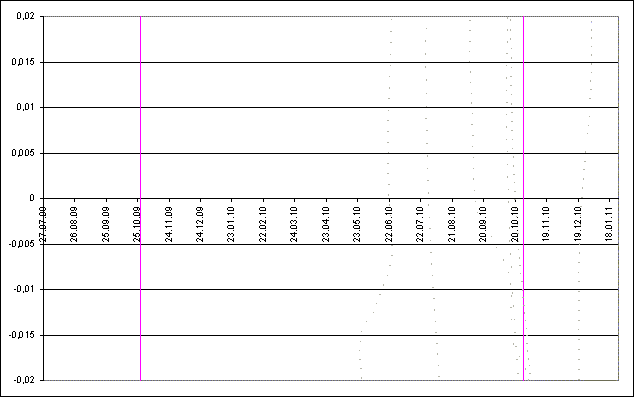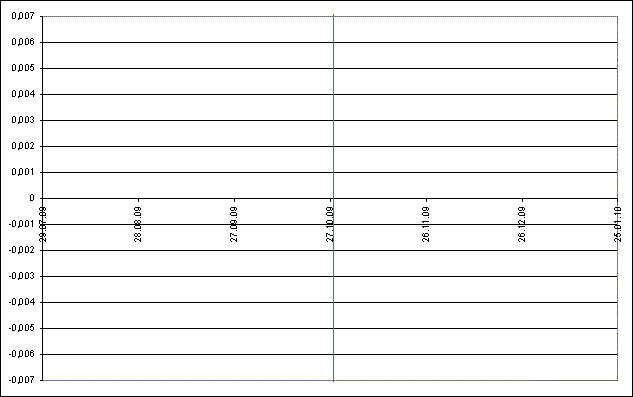185P-ids 2009-2010: prediction of activity

Fig. 1. Space-temporal projection of 73P-ids trails parts onto their minimal distance to the Earth orbit passages (correspondence between colours of the particles and their ejection velocities can be seen here).

Fig. 2. Detailed space-temporal projection of Perseids trails parts onto their minimal distance to the Earth orbit passages for 2009 (correspondence between colours of the particles and their ejection velocities can be seen here).

Fig. 3. Detailed space-temporal projection of Perseids trails parts onto their minimal distance to the Earth orbit passages for 2010 (correspondence between colours of the particles and their ejection velocities can be seen here).
2010
The Fig.3 shows that on 22 Decemner 2010 the Earth orbit is intersected by a trail on the solar longitude of 277.221°. This is the 1932 trail. It intersectes the Earth orbit just 6.53 days after the Earth itself passes the point of intersection. However the characteristics of this past of trail are very unfavorable - very high ejection velocity Vej=81.5 m/s and moderate density (fM(fMD)=0.423) make null chances of any activity, even in radiorange.
References
1. "Comet's dust 2.0" program by S. Shanov and S. Dubrovsky. [Used for computation of stream particles orbital evolution]
2. Kazuo Kinosita, http://www9.ocn.ne.jp/~comet/index.html [Orbital elements of the comet 185P.]
3. Lyytinen E, van Flandern T. "Predicting the strength of Leonid outbursts", 2000, Icarus, P. 158-160.
The Fig.3 shows that on 22 Decemner 2010 the Earth orbit is intersected by a trail on the solar longitude of 277.221°. This is the 1932 trail. It intersectes the Earth orbit just 6.53 days after the Earth itself passes the point of intersection. However the characteristics of this past of trail are very unfavorable - very high ejection velocity Vej=81.5 m/s and moderate density (fM(fMD)=0.423) make null chances of any activity, even in radiorange.
References
1. "Comet's dust 2.0" program by S. Shanov and S. Dubrovsky. [Used for computation of stream particles orbital evolution]
2. Kazuo Kinosita, http://www9.ocn.ne.jp/~comet/index.html [Orbital elements of the comet 185P.]
3. Lyytinen E, van Flandern T. "Predicting the strength of Leonid outbursts", 2000, Icarus, P. 158-160.